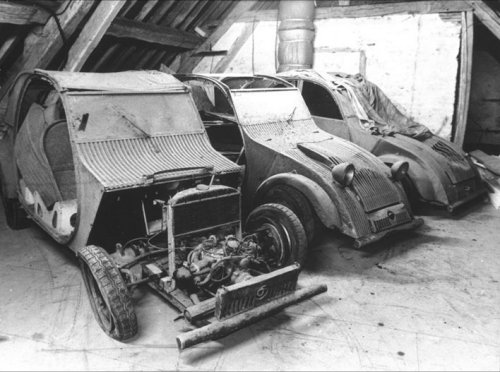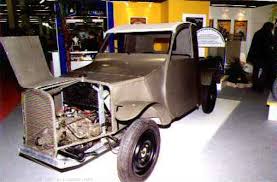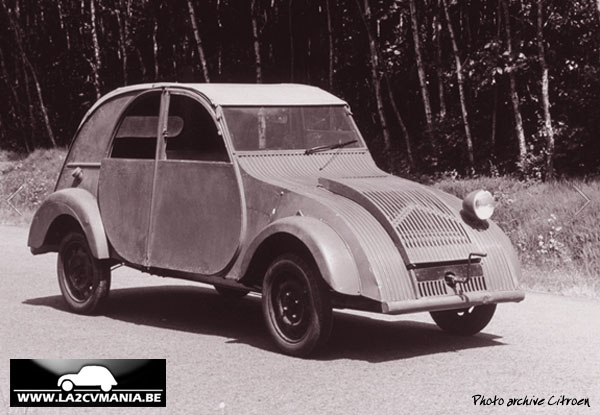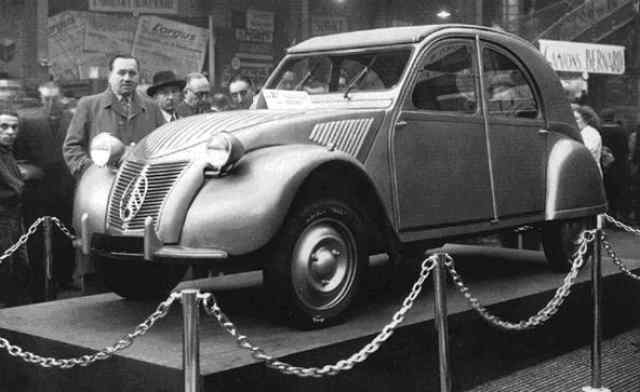CITROňN 2CV 1948-1990

 In 1936, Jean-Pierre Boulanger (Andrť CitroŽn's successor) ordered CitroŽn engineers to develop an economic little car which would be capable of transporting 4 adults and 50kg of luggage in great comfort at speeds up to 50 kilometres per hour and at a fuel consumption of no more than 3 litres per 100 kilometres. Additionally it was required that the suspension system should allow driving across a ploughed field with a basket of eggs without breaking one of them and the car would have to be very simple so that a farmerís wife could drive it. These bizarre specifications led to a car which would become one of the automotive legends of this century - the 2CV.
In 1936, Jean-Pierre Boulanger (Andrť CitroŽn's successor) ordered CitroŽn engineers to develop an economic little car which would be capable of transporting 4 adults and 50kg of luggage in great comfort at speeds up to 50 kilometres per hour and at a fuel consumption of no more than 3 litres per 100 kilometres. Additionally it was required that the suspension system should allow driving across a ploughed field with a basket of eggs without breaking one of them and the car would have to be very simple so that a farmerís wife could drive it. These bizarre specifications led to a car which would become one of the automotive legends of this century - the 2CV.
Between 1936 and 1939 a set of TPV (Toute Petite Voiture) prototypes were designed by CitroŽn engineers. In 1939 the CitroŽn company intended to introduce its newest car at the October Automobile Show, but all was cancelled because of the outbreak of war in September. To keep the project secret, CitroŽn ordered that all of the 500 prototypes and pre-series cars be destroyed but a few were carefully concealed.
 After the war it took CitroŽn three more years before the 2CV was unveiled at the 1948 Paris Salon d'Automobile. The French press was stunned. This could not be serious: CitroŽn made itself ridiculous by introducing such an ugly car. If nothing else, it generated enormous discussion with some predicting the 2CV a successful future while others saw an industrial failure.
After the war it took CitroŽn three more years before the 2CV was unveiled at the 1948 Paris Salon d'Automobile. The French press was stunned. This could not be serious: CitroŽn made itself ridiculous by introducing such an ugly car. If nothing else, it generated enormous discussion with some predicting the 2CV a successful future while others saw an industrial failure.
On the strict orders of Boulanger, CitroŽn distributed the 2CV only to those selected by the factory. Only farmers, country doctors, artists and a few others could buy one and thus started its cult reputation. Because French performance artists drove around in 2CVs the car got a lot of exposure and became popular in a very short time.
 The car was manufactured from 1949 until 1990. A lot of major and minor changes were made which led to the latest version we presently know. The engine grew from 375 cc. to 602 cc. while the power increased from 9 to 28 bhp. The maximum speed climbed from 70 to 117 kilometres per hour (37 to 75 mph).
The car was manufactured from 1949 until 1990. A lot of major and minor changes were made which led to the latest version we presently know. The engine grew from 375 cc. to 602 cc. while the power increased from 9 to 28 bhp. The maximum speed climbed from 70 to 117 kilometres per hour (37 to 75 mph).
There were lots of derivatives of this popular little car. The first was a van model called AK [AU, not AK] later AK250, AK350 and AK400. Then a luxury derivative was revealed: the AMI 6 which had a reverse slope rear window and the looks of a modern car (in the early sixties). In 1967 the supposed successor of the 2CV was introduced which went by the name DYANE. It lasted until 1984 and faded into oblivion. In 1968 the fun car MEHARI was introduced as an innovative model with its plastic body. The AMI 8 replaced the old AMI 6. Later CitroŽn introduced one of the first ĎQ carsí by putting the GS 1015 cc flat4 cylinder engine into the AMI 8, the Super was born and was the fastest of the 2CV derivatives.
The last 2CV was left the Portuguese plant on July 27th 1990 at 16:00 GMT sharp. In more than 40 years the 'Deuche' and a large variety of derivative models became world famous. 3,872,583 units (2CV saloon/van) and 3,428,695 of the other models were produced in over 15 countries including Argentina, Belgium, Chile, Portugal, Iran and others.
The CitroŽn 2CV is not a car, its a way of life.